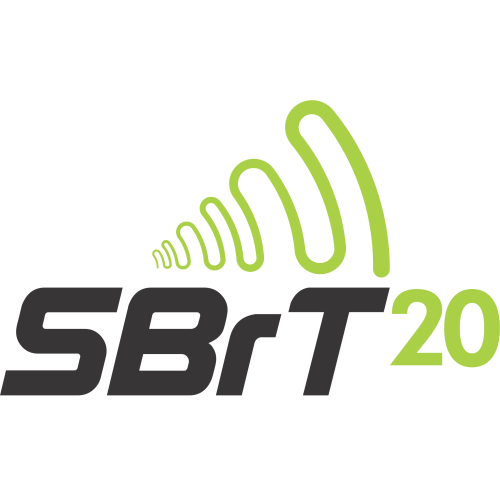
XXXVIII Simpósio Brasileiro de Telecomunicações e Processamento de Sinais
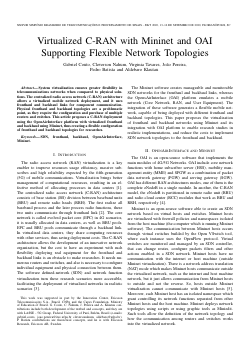
Virtualized C-RAN with Mininet and OAI Supporting Flexible Network Topologies
Gabriel Couto, Cleverson Nahum, Virgínia B Tavares, João Pereira, Pedro dos Santos Batista, Aldebaro Klautau
DOI: 10.14209/SBRT.2020.1570657866
Keywords: SDN OpenAirInterface Mininet
Abstract
System virtualization ensures greater flexibility to improve the resource management of telecommunication and network applications when compared with physical solutions. The centralized radio access network (C-RAN) architecture enables cloud processing, making functions virtualization possible in a mobile network deployment. C-RAN components communication occurs through fronthaul and backhaul links, where both have different topologies, interfaces, and requirements. Experimentation with different fronthaul and backhaul topologies may be difficult to setup and expensive since it requires numerous routers and switches. This paper proposes a C-RAN deployment using the OpenAirInterface platform with virtualized fronthaul and backhaul using Mininet which enables easier setup of fronthaul and backhaul topologies.Download
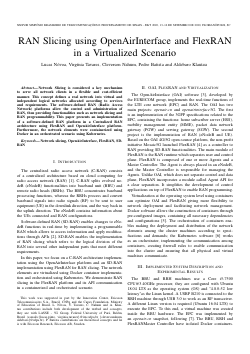
RAN Slicing using OpenAirInterface and FlexRAN in a Virtualized Scenario
Lucas Nóvoa, Virgínia B Tavares, Cleverson Nahum, Pedro dos Santos Batista, Aldebaro Klautau
DOI: 10.14209/SBRT.2020.1570657929
Keywords: Network slicing OpenAirInterface FlexRAN SD-RAN
Abstract
Network Slicing is considered a key mechanism to serve all network clients in a flexible and cost-efficient manner. This concept defines a real network into virtual and independent logical networks allocated according to services and requirements. The software-defined RAN (Radio Access Network) platforms allow the control and administration of RAN, thus providing functionalities such as network slicing and RAN programmability. This paper presents an implementation of a software-defined RAN platform in a Centralized RAN architecture using FlexRAN and OpenAirInterface platform. Furthermore, the network elements were containerized using Docker in an orchestrated scenario using Kubernetes.Download
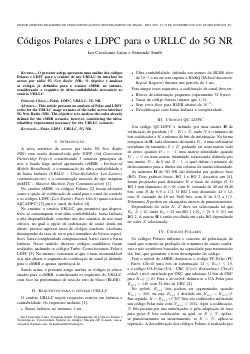
Códigos Polares e LDPC para o URLLC do 5G NR
Ian Cavalcante Lima, Fernanda Smith
DOI: 10.14209/SBRT.2020.1570657957
Keywords: Polar LDPC URLLC 5G NR
Abstract
This article presents an analysis of Polar and LDPC codes for the URLLC usage scenario of the radio access interface 5G New Radio (NR). The objective is to analyze the codes already defined for the eMBB scenario, however, considering the ultra-reliability requirement necessary for the URLLC scenario.Download
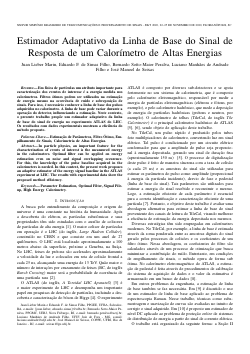
Estimador Adaptativo da Linha de Base do Sinal de Resposta de um Calorímetro de Altas Energias
Juan Marin, Eduardo Simas Filho, Bernardo S Peralva, Luciano Filho, José de Seixas
DOI: 10.14209/SBRT.2020.1570657975
Keywords: Parameter Estimation Optimal Filter Signal Pile-up High Energy Physics
Abstract
Em física de partículas um atributo importante para caracterização dos eventos de interesse é a energia medida nos calorímetros. Filtros ótimos podem ser utilizados na estimação de energia mesmo na ocorrência de ruído e sobreposição de sinais. Para isso, é necessário conhecer a linha de base dos pulsos adquiridos no calorímetro. A linha de base pode variar durante a operação do detector, influenciando a estimação. Neste contexto, o presente trabalho propõe um estimador adaptativo da linha de base do sinal de energia no experimento ATLAS do LHC. Os resultados com dados experimentais mostram a eficiência do método proposto.Download

Representação linear e caracterização espectral de sinais caóticos usando filtros lineares
Rafael Alves da Costa, Marcio Eisencraft
DOI: 10.14209/SBRT.2020.1570658001
Keywords: chaotic signals nonlinear systems power spectral density recursive filters
Abstract
In this paper, we present a discrete-time linear recursive filter representation for a piecewise-linear map that generates chaotic signals. It can be used to easily deduce analytical formulas for power spectral density of chaotic signals, providing useful results for chaos-based communication systems and signal processing. Numerical simulations are used to validate the theoretical results.Download
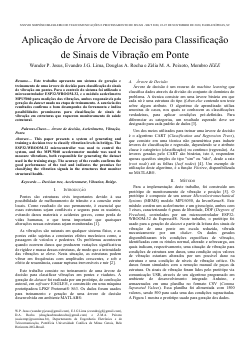
Aplicação de Árvore de Decisão para Classificação de Sinais de Vibração em Ponte
Wander P. Jesus, Evandro Lima, Douglas Rocha, Zelia M A Peixoto
DOI: 10.14209/SBRT.2020.1570658018
Keywords: Árvore de Decisão Acelerômetro Vibração Ponte
Abstract
Este trabalho apresenta um sistema de geração e treinamento de uma árvore de decisão para classificação de sinais de vibração em pontes. Para o controle do sistema foi utilizado o microcontrolador ESP32-WROOM-32, e o módulo acelerômetro MPU5060 para medições das vibrações, ambos responsáveis pela geração do dataset usado na etapa de treinamento. A acurácia dos resultados confirma o bom desempenho da ferramenta e indica possibilidades promissoras para classificação de sinais de vibração em estruturas que requerem monitoramento de saúde estrutural.Download

Underwater target classification with optimized feature selection based on Genetic Algorithms
Rigel Fernandes, José Antonio Apolinário Jr.
DOI: 10.14209/SBRT.2020.1570658075
Keywords:
Abstract
This paper presents an approach to target-classification optimization based on acoustic signals collected using a hydrophone, an underwater electroacoustic transducer. This study has applications to sonars or any sound-classification application. We divide the problem into three parts, namely feature extraction, feature selection, and target classification with an optimization step. Experiments were conducted using ShipsEar, a public database of raw ship noises collected using a single hydrophone located in a harbor. This dataset comprises five classes and is used to verify the performance of the approach described in this work. From raw signals, we extracted the following features: Mel-Frequency Cepstral Coefficients, Linear Predictive Coding, and Gammatone Cepstral Coefficients. All these features were evaluated using the Neighborhood Component Analysis to reduce dimensionality. We used K-Nearest Neighbors as the classifier. We adopted the leave-one-out cross-validation strategy to evaluate the classifier. Finally, we used Genetic Algorithms to optimize the features selected. We set the classifier performance as the genetic algorithm cost function and used the features selected as one individual of the first generation. This scheme optimized the performance of the classifier by 13 percentage points. In our case, the optimized feature selection algorithms reduced the dimensionality and improved classifier accuracy when compared with the same scheme using all features or a subset of features selected by Neighborhood Component Analysis. These techniques can select the most useful information from features of different ship classes.Download

Antenas Dual-Band MIMO de Microfita para Aplicações em Faixas de Frequências 5G
Valdemir Praxedes da Silva Neto, Madson Franklin do Nascimento, Kaio Márcio da Costa Bandeira, Cristhianne de Fátima Linhares de Vasconcelos
DOI: 10.14209/SBRT.2020.1570658120
Keywords: 5G Antena de microfita MIMO Antena impressa
Abstract
This article presents the development and analysis of new geometries of Dual-Band MIMO antennas (Multiple Input Multiple Output), compact, resonating at 2.3 GHz and 3.5 GHz for application in the new technology of fifth generation wireless communication (5G). The High Frequency Structure Simulator (HFSS) software was used in the simulation to obtain the desired results. An experimental characterization based on the construction of prototypes was performed and the measurements obtained show a good agreement between the experimental results and the results obtained through simulations.Download
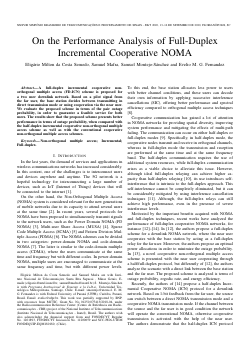
On the Performance Analysis of Full-Duplex Incremental Cooperative NOMA
Eligário Milton Da Costa Semedo Jr, Samuel Mafra, Samuel Montejo-Sánchez, Evelio Fernandez
DOI: 10.14209/SBRT.2020.1570658141
Keywords: Non-orthogonal multiple access Incremental Full-duplex
Abstract
A full-duplex incremental cooperative non-orthogonal multiple access (FD-ICN) scheme is proposed for a two user downlink network. Based on a pilot signal from the far user, the base station decides between transmitting in direct transmission mode or using cooperation via the near user. We evaluate the proposed scheme in terms of the pair outage probability, in order to guarantee a feasible service for both users. The results show that the proposed scheme presents better performance in terms of outage probability, when compared with the half-duplex incremental cooperative non-orthogonal multiple access scheme as well as with the conventional cooperative non-orthogonal multiple access schemes.Download

On the Performance of Transmit Antenna Selection for Physical-Layer Security of NOMA Systems Under Untrusted Users
Jones Marcio Nambundo Jr, Samuel Mafra, Samuel Montejo-Sánchez
DOI: 10.14209/SBRT.2020.1570658143
Keywords: Non-orthogonal multiple access Physical-layer security Secrecy outage probability Untrusted users
Abstract
In this paper, the physical layer security for a two-user downlink NOMA cluster, between a near trusted user and a far untrusted user, subject to Nakagami- m fading is investigated. It is considered an scenario with a multiple antenna base station, in which the antenna with best channel for the near user is selected. The pair outage probability and secrecy outage probability are analyzed to verify the system performance gain. Results show improvements in the pair outage probability and secrecy outage probability when the relative distance between the trusted user and the BS decreases, its link has direct line of sight and/or the number of base station antennas increases.Download